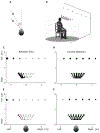Mapping the neglected space: gradients of detection revealed by virtual reality
- PMID: 21746873
- PMCID: PMC8767418
- DOI: 10.1177/1545968311410068
Mapping the neglected space: gradients of detection revealed by virtual reality
Abstract
Background: Spatial neglect affects perception along different dimensions. However, there is limited availability of 3-dimensional (3D) methods that fully map out a patient's volume of deficit, although this could guide clinical management.
Objective: To test whether patients with neglect exhibit simple contralesional versus complex perceptual deficits and whether deficits are best described using Cartesian (rectangular) or polar coordinates.
Methods: Seventeen right-hemisphere persons with stroke (8 with a history of neglect) and 9 healthy controls were exposed to a 3D virtual environment. Targets placed in a dense array appeared one at a time in various locations.
Results: When tested using rectangular array of targets, subjects in the neglect group exhibited complex asymmetries across several dimensions in both reaction time and target detection rates. Paper-and-pencil tests only detected neglect in 4 of 8 of these patients. When tested using polar array of targets, 2 patients who initially appeared to perform poorly in both left and near space only showed a simple left-side asymmetry that depended almost entirely on the angle from the sagittal plane. A third patient exhibited left neglect irrespective of the arrangements of targets used. An idealized model with pure dependence on the polar angle demonstrated how such deficits could be misconstrued as near neglect if one uses a rectangular array.
Conclusions: Such deficits may be poorly detected by paper-and-pencil tests and even by computerized tests that use regular screens. Assessments that incorporate 3D arrangements of targets enable precise mapping of deficient areas and detect subtle forms of neglect whose identification may be relevant to treatment strategies.
Conflict of interest statement
Declaration of Conflicting Interests
The author(s) declared no potential conflicts of interest with respect to the research, authorship, and/or publication of this article.
Figures




Similar articles
-
Assessment of post-stroke extrapersonal neglect using a three-dimensional immersive virtual street crossing program.Acta Neurol Scand. 2010 Mar;121(3):171-7. doi: 10.1111/j.1600-0404.2009.01194.x. Epub 2009 Oct 15. Acta Neurol Scand. 2010. PMID: 19839943
-
Assessment of visuospatial neglect in stroke patients using virtual reality: a pilot study.Int J Rehabil Res. 2009 Dec;32(4):280-6. doi: 10.1097/MRR.0b013e3283013b1c. Int J Rehabil Res. 2009. PMID: 18446089
-
Multi-tasking uncovers right spatial neglect and extinction in chronic left-hemisphere stroke patients.Neuropsychologia. 2016 Nov;92:147-157. doi: 10.1016/j.neuropsychologia.2016.02.028. Epub 2016 Mar 3. Neuropsychologia. 2016. PMID: 26948071
-
Uses of virtual reality for diagnosis, rehabilitation and study of unilateral spatial neglect: review and analysis.Cyberpsychol Behav. 2009 Apr;12(2):175-81. doi: 10.1089/cpb.2008.0208. Cyberpsychol Behav. 2009. PMID: 19361298 Review.
-
[Neurobiology of neglect: implications for new therapeutic strategies].Fortschr Neurol Psychiatr. 2010 Dec;78(12):733-45. doi: 10.1055/s-0029-1245862. Epub 2010 Dec 6. Fortschr Neurol Psychiatr. 2010. PMID: 21136342 Review. German.
Cited by
-
Immersive virtual reality gameplay detects visuospatial atypicality, including unilateral spatial neglect, following brain injury: a pilot study.J Neuroeng Rehabil. 2023 Nov 23;20(1):161. doi: 10.1186/s12984-023-01283-9. J Neuroeng Rehabil. 2023. PMID: 37996834 Free PMC article.
-
Virtual reality for the assessment and rehabilitation of neglect: where are we now? A 6-year review update.Virtual Real. 2022;26(4):1663-1704. doi: 10.1007/s10055-022-00648-0. Epub 2022 May 30. Virtual Real. 2022. PMID: 35669614 Free PMC article.
-
Immersive 3D Virtual Reality Cancellation Task for Visual Neglect Assessment: A Pilot Study.Front Hum Neurosci. 2020 May 25;14:180. doi: 10.3389/fnhum.2020.00180. eCollection 2020. Front Hum Neurosci. 2020. PMID: 32528265 Free PMC article.
-
The Neuropsychological Assessment of Unilateral Spatial Neglect Through Computerized and Virtual Reality Tools: A Scoping Review.Neuropsychol Rev. 2024 Jun;34(2):363-401. doi: 10.1007/s11065-023-09586-3. Epub 2023 Mar 13. Neuropsychol Rev. 2024. PMID: 36913099 Free PMC article.
-
User perspective and higher cognitive task-loads influence movement and performance in immersive training environments.BMC Biomed Eng. 2019 Aug 30;1:21. doi: 10.1186/s42490-019-0021-0. eCollection 2019. BMC Biomed Eng. 2019. PMID: 32903314 Free PMC article.
References
-
- Robertson IH, Halligan PW. Spatial Neglect: A Clinical Handbook for Diagnosis and Treatment. Hove, UK: Psychology Press; 1999.
-
- Cherney LR, Halper AS, Kwasnica CM, Harvey RL, Zhang M. Recovery of functional status after right hemisphere stroke: Relationship with unilateral neglect. Arch Phys Med Rehabil. 2001;82:322–328. - PubMed
-
- Gillen R, Tennen H, McKee T. Unilateral spatial neglect: Relation to rehabilitation outcomes in patients with right hemisphere stroke. Arch Phys Med Rehabil. 2005;86:763–767. - PubMed
-
- Paolucci S, Antonucci G, Grasso MG, Pizzamiglio L. The role of unilateral spatial neglect in rehabilitation of right brain-damaged ischemic stroke patients: a matched comparison. Arch Phys Med Rehabil. 2001;82:743–749. - PubMed
Publication types
MeSH terms
Grants and funding
LinkOut - more resources
Full Text Sources
Other Literature Sources

